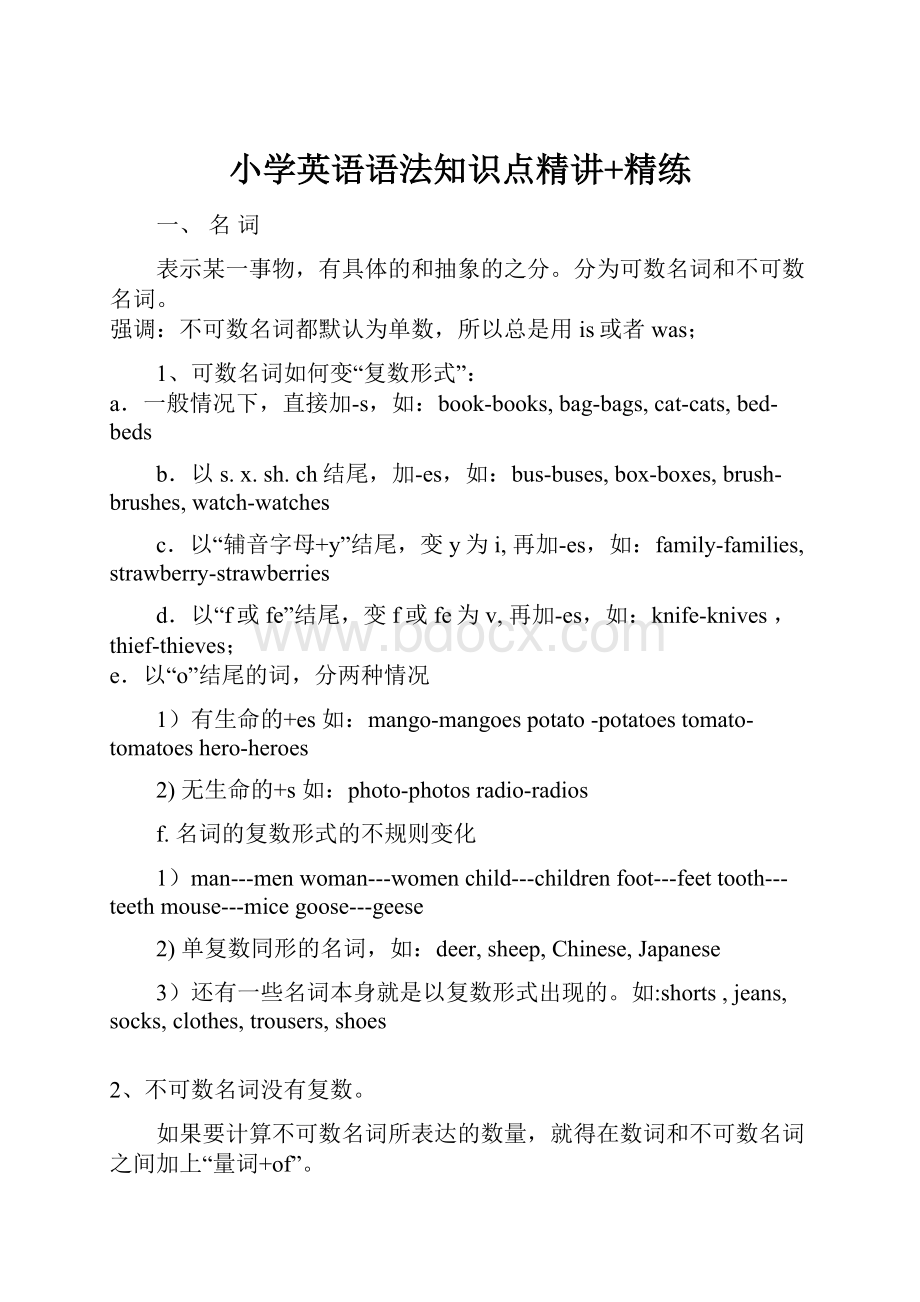小学英语语法知识点精讲+精练Word文档格式.docx
《小学英语语法知识点精讲+精练Word文档格式.docx》由会员分享,可在线阅读,更多相关《小学英语语法知识点精讲+精练Word文档格式.docx(33页珍藏版)》请在冰豆网上搜索。

I_____
him_____
this_____her_____watch_____mango_____
child_____photo_____diary_____
day________
foot________dress________tooth_______sheep______
box_______
strawberry_____thief_______engineer______peach______
sandwich______
man______
woman_______
leaf_______
people________
2、用所给名词的正确形式填空。
(1)Aretheretwo
(box)onthetable?
(2)Icanseesome
(people)inthecinema.
(3)Howmany
(day)arethereinaweek?
(4)Here’refive
(bottle)of
(juice)foryou.
(5)This
(violin)ishers.Those
(grape)areoverthere.
二、冠
词
冠词是一种虚词,不能独立使用,通常放在名词的前面,分为“不定冠词”和“定冠词”两种。
1、不定冠词:
a、an。
用在单数名词前,表示“一个,一件……”。
an用在以元音“音素”开头的单词前。
如:
ane-mail,anorange,anoldman,anhour…
a用语辅音音素开头的单词前,如:
abook,apen
2、定冠词:
the用在单数或者复数名词前。
the没有具体意思,有时翻译为这、那。
它的基本用法:
(1)用来表示特指某(些)人或某(些)事物。
Themaponthewallisnew.
(2)表示说话者双方都知道的人或事物。
Lookatthepicture,please.
(3)表示再次提到前面谈过的人或事物。
Thisisastamp.Thestampisbeautiful.
(4)用在表示世界上独一无二的事物前。
thesun太阳
themoon月亮
theearth地球
(5)用在由普通名词构成的专有名词前。
theGreatWall长城
(6)用在江河、湖海等专有名词前。
theChangjiangRiver长江
(7)此外,序数词、形容词最高级、乐器名称等词前面和一些习惯用语中一般都用定冠词the,如:
thefirstday,thebestboy,playthepiano,inthesameclass
1、用a或an填空。
____“U”
____ice-cream
____
goalkeeper
____teapot
____apple
____office
____Englishbook
____umbrella____unit
____hour
2、根据需要,填写冠词a,an或the。
(1)Whois
____girlbehind
____tree?
(2)
____oldmanhastwochildren,
____sonand
____daughter.
(3)Thisis
____orange.
____orangeisLucy’s.
(4)Helikesplaying
____guitar.Wehave
____samehobby.
(5)Weallhad____goodtimelastSunday.
(6)Shewantstobe____doctor.
三数词
基数词和序数词。
基数用于表示数量多少,而基数词用于表示次序,常在日期中出现。
区别:
基数词前面没有“the”;
序数词前一定要有“the”。
1、超过二十以上的两位数需要在个位和十位之间加上“-”。
21
twenty-one
2、三位数以上的则需要在百位数后再加上and。
101
a/onehundredandone
3、用基数词来修饰可数名词时,一定别忘了它的复数形式。
十八个男孩
eighteenboys
4、用基数词修饰不可数名词时,如是复数,变它的量词为复数。
单数
复数
人称代词
主格
I
you
he
she
it
we
they
宾格
me
him
her
us
them
物主代词
形容词性
my
your
his
its
our
their
名词性
mine
yours
hers
ours
theirs
两碗米饭
twobowlsofrice
5、序数词一般加“th”,特殊的有:
first,second,third,fifth,eighth,ninth,twelfth以及二十及二
十以外的整十:
twentieth,thirtieth,fortieth…“第几十几”:
前面整十不变,后面“几”改为序
数词。
88
eighty-eighth
1、请翻译下列短语。
(1)60名学生
(2)15本英语书
(3)九杯凉水
(4)4个孩子
(5)12月31
(6)6月2日
(7)第九周
(8)40年前
(9)
(10)第一天
2、把下列基数词改成序数词。
one---
two---
three---
nine---
fourteen---
twenty---
thirty-five---
eighty-one---five----
四、代
指示代词:
指示说明近处或远处、上文或下文、以前或现在的人或事物
单数复数含义
This(这个)these(这些)指较近的人或物
That(那个)those(那些)指较远的人或物
注意:
打电话时用this介绍自己,that询问对方,如ThisisKatespeaking.Whoisthat?
人称代词:
1、人称代词分为:
第一、第二、第三人称,且有单复数之分。
2、人称代词的主格在句中做主语,一般用在动词前(疑问句除外);
宾格在句中做宾语,多
用于动词、介词后。
3、形容词性物主代词起形容词的作用,后面一定要跟名词,表示该名词是属于谁的。
4、名词性物主代词=形容词性物主代词+名词。
Thisismybag.=Thisismine.
Thatisherruler.=Thatishers.
一般看后面有没有名词,如有,就用形容词性物主代词;
如无,就用名词性物主代词。
请牢记下表:
人称代词
物主代词
第一人称
第二人称
第三人称
1、按要求写出相应人称代词。
I(宾格)_______
she(形容词性物主代词)_______
we(名词性物主代词)_______
he(复数)_______
us(单数)_______
theirs(主格)_______its(宾格)_______
2、想一想,把下表补充完整
3、用所给词的适当形式填空。
1)Thatisnot_________kite.Thatkiteisverysmall,but_________isverybig.(I)
2)Thedressis_________.Giveitto_________.(she)
3)Isthis_________watch?
(you)No,it’snot_________.(I)
4)_________ismybrother.________nameisJack.Look!
Thosestampsare_________.(he)
5)_________dressesarered.(we)Whatcolourare_________?
(you)
6)Show_________yourkite,OK?
(they)
7)Ihaveabeautifulcat._________nameisMimi.Thesecakesare_________.(it)
8)Arethese________tickets?
No,________arenot_________.________aren’there.(they)
9)Shall_________havealookatthatclassroom?
Thatis_________classroom.(we)
10)_________ismyaunt.Doyouknow_________job?
_________isanurse.(she)
11)Whereare_________?
Ican’tfind_________.Let’scall_________parents.(they)
12)Don’ttouch_________._________isnotacat,_________isatiger!
(it)
13)_________sisterisill.Pleasegoandsee_________.(she)
14)Thegirlbehind_________isourfriend.(she)
五、形容词、副词
1、形容词表示某一事物或人的特征,副词表示某一动作的特征。
形容词和副词的比较级和最高级
构成方法
原级
比较级(表示两个人、物之间进行比较时),由比较级+than构成
最高级(大于等于三个人、物之间进行比较),由the+形容词或副词最高级
一般在词尾加-er,est
tall,long,old
taller,longer,older
tallest,longest,oldest
以e结尾的词,直接加-r,est
nice,fine,large
nicer,finer,larger
nicest,finest,largest
以辅音+y结尾的词,先把y改成i,再加-er,est
busy,early,easy
busier,earlier,easier
busiest,earliest,easiest
以“辅元辅”结构结尾的词,先双最后一个辅音字母,再加-er,est
big,hot,red,thin
bigger,hotter,thinner
biggest,hottest,thinest
少数以-er,-ow结尾的双音节词末尾加-er,est
clever,narrow
cleverer,narrower
cleavest,narrowest
其他双音节词和多音节词,在前面加more,most
important,easily
moreimportant,moreeasily
mostimportant,mosteasily
常用的不规则变化的形容词的比较级和最高级:
原级-----------------比较级------------最高级
good/well-----------better-------------best
many----------------more--------------most
much/many--------more--------------most
little------------------less----------------least
bad/badly/ill-------worse--------------worst
old------------------older/elder---------oldest/eldest
far------------------farther,further-----farthest,furthest
1、写出下列形容词、副词的比较级、最高级
big
good
long
tall
old
short
thin
heavy
young
fat
light
strong
high
far
low
early
late
well
fast
slow
2、用括号内所给单词的适当形式填空。
1)Icanswimas
_______(fast)asthefish,Ithink.
2)Look!
Hishandsare
_______
(big)thanmine.
3)Ithinkyoudothesethings_______(well)thanyourclassmates.
4)Whosebagis
_______(heavy),yoursormine?
5)DoesJimrunas
_______(slow)asDavid?
Yes,butMikeruns_______(slow)thanthem.
6)Youhavesevenbooks,butIhave
_______(many)thanyou.Ihaveten.
7)Ijump
_______(far)thansomeoftheboysinmyclass.
8)I’mvery_______(thin),butshe’s
_______(thin)thanme.
9)Itgets
_______and_______(warm)whenspringcomeshere.
六、介
1、是虚词,不能单独使用,它只有跟它后面的宾语一起构成介词短语,才能在句子中起作用。
有:
in,on,under,with,behind,about,near,before,after,for,to,up,down,from,infrontof,outof,
2、表示时间的介词有:
at,on,in。
(1)at表示“在某一个具体的时间点上”,或用在固定词组中。
atteno’clock,at9:
30a.m.,
(2)on表示“在某日或某日的时间段”。
onFriday,onMondaymorning,onMay1st
(3)in表示“在某一段时间(月份、季节)里”。
intheafternoon,inSeptember,in2005…
3、in一词还有其他的固定搭配,如:
inblue(穿着蓝色的衣服),inEnglish(用英语表达)
1、选用括号内恰当的介词填空。
1)What’sthis
_______(at,on,in)English?
2)Christmasis
_______(at,on,in)the25thofDecember.
3)Theman_______(with,on,in)blackisSuHai’sfather.
4)Hedoesn’tdowell
_______(at,on,in)PE.
5)Lookatthosebirds
_______(on,in)thetree.
6)Wearegoingtomeet
_______(at,on,in)thebusstop
_______(at,on,in)halfpastten.
7)Isthereacat
_______(under,behind,in)thedoor?
8)Helen’swritingpaperis
_______(in,infrontof)hercomputer.
9)Welive
_______(at,on,in)anewhousenow.
10)Doesitoftenrain
_______(at,on,in)springthere?
2、圈出下列句子中运用不恰当的介词,并将正确的答案写在横线上。
1)JimisgoodinEnglishandMaths.
2)Thefilmswereinthegroundjustnow.
3)Theyaretalkingtotheirplans.
4)HowmanystudentshavetheirbirthdaysonMay?
5)Women’sDayisatthethirdofMarch.
6)Icanjogtoschoolonthemorning.
7)Didyouwatertreesatthefarm?
8)CanyoucomeandhelpmeonmyEnglish?
9)IusuallytakephotosinSundaymorning.
10)WhatdidyoudoontheSpringFestival?
七、动
这里所说的动词是指各种动词总称,其中包括be动词、情态动词、助动词、行为动词
动词、名词和形容词不太容易区分,如不能一眼看出,可用如下方法:
先用“一(量词)”(如